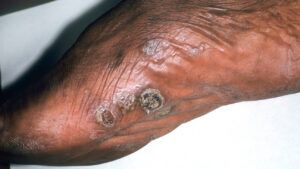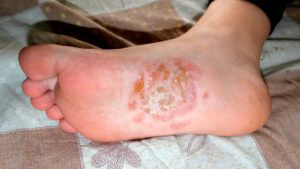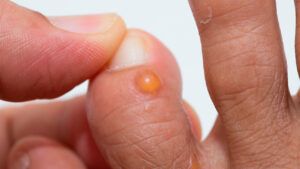Dyshidrotic eczema is a type of eczema that produces skin blisters on the feet and hands. Some people refer to these blisters as stress bumps, although this is not a medical term.
Doctors may also refer to dyshidrotic eczema as dyshidrosis, pompholyx, foot-and-hand eczema, vesicular eczema, or palmoplantar eczema.
The blisters or bumps that form can be uncomfortable, itchy, and painful. People may feel a burning or prickly sensation in their skin, though the blisters are not permanent.
Dyshidrotic eczema involves flare-ups that last several weeks. Although some people may only experience one flare, they usually have repeated flare-ups that may occur from once every month to once every year.
Below, we look at the symptoms, causes, risk factors, and treatment options for dyshidrotic eczema and how diet may affect this condition.



Doctors sometimes call dyshidrotic eczema “pompholyx eczema.”
Pompholyx is the word for “bubble” in Ancient Greek. The condition can produce intensely itchy blisters on the skin that can also be painful or cause a burning sensation.
Water-filled blisters can appear on the sides of the fingers and may extend to the palms of the hands. They can also appear on the toes and soles of the feet. People with dyshidrotic eczema can have other types of eczema elsewhere on the body.
Dyshidrotic eczema may occur as a one-time episode. However, it often occurs as a chronic condition that involves repeated flare-ups.
Symptoms of dyshidrotic eczema include:
- extreme itching
- burning sensations
- a sensation of heat in the palms or soles
- prickling sensations
- the sudden appearance of small blisters, often on the sides of the fingers
- painful drying and cracking of the skin
- swelling and changes to the skin around the nail
The blisters start small and then may grow bigger, weep fluid, and cause skin discoloration. They do not appear in other places on the body.
If a person has small, water-filled blisters elsewhere, it may be another form of eczema or another skin condition.
The bumpy blisters on the sides of the fingers may develop due to excessive sweating or heat exposure. This is why people sometimes refer to them as “summer finger bumps.”
There is no definitive known cause for dyshidrotic eczema. However, some factors that may trigger flare-ups include:
- stress
- metal allergies or sensitivities, such as a nickel allergy
- other types of allergies, such as seasonal allergies
- sweating
- hot, humid weather
According to the National Eczema Society, half of those with dyshidrotic eczema also have atopic eczema or a family history of the skin condition.
Dyshidrotic eczema is more common in people under 40 years of age. It is also more common in females. According to the American Academy of Dermatology, other risk factors include:
- having another type of eczema
- having seasonal allergies or asthma
- having an allergy to certain metals
- having feet or hands that frequently sweat or become wet
- having a family history of dyshidrotic eczema
- working with metals
- being a mechanic
- working with cement
A person with symptoms of dyshidrotic eczema needs to consult a doctor or dermatologist for a diagnosis. The doctor will examine the person’s skin and take a medical and family history to determine a diagnosis and treatment plan.
A doctor may also recommend allergy testing to check for specific triggers that may be worsening the eczema.
Though there is no cure for dyshidrotic eczema, there are ways to manage the condition. A doctor may prescribe:
- a medical moisturizer
- wet soaking with potassium permanganate to help with oozing blisters
- topical steroids to reduce inflammation
- a topical calcineurin inhibitor such as tacrolimus ointment (Protopic)
- oral antibiotics to combat bacterial infection
- oral immunosuppressant drugs
- Botox injections
- phototherapy
Managing a flare-up of dyshidrotic eczema can be difficult. The condition is often very itchy and can be painful and bothersome.
The National Eczema Society suggests some strategies for at-home relief, including:
- washing with lukewarm water, as very hot or cold water may irritate the skin
- using an emollient soap or cleanser instead of regular soap
- avoiding direct contact with skin-irritating ingredients or products such as detergents and cleansing agents
- taking antihistamines with a sedative effect that will help with sleep rather than actively treat itchiness
- bandaging or wrapping the skin after applying creams or ointments
Stress management can also help prevent flare-ups.
Dietary triggers may contribute to flare-ups for some people. Avoiding these foods can help prevent symptoms.
As a nickel allergy may have a link to dyshidrotic eczema, it is possible that avoiding foods high in nickel may help prevent flare-ups. These foods include:
An infection may develop as the blisters grow larger, compromising the skin barrier. Some people may also have fungal infections at the same time as they experience dyshidrotic eczema flare-ups.
If a person with dyshidrotic eczema develops a skin infection, they need to consult a doctor for evaluation so they can receive treatment.
Some symptoms of a skin infection include:
- skin discoloration
- swelling
- oozing pus
- pain
- warmth
Preventing flares involves avoiding known triggers such as allergens or temperature changes. Other strategies for preventing dyshidrotic eczema and its symptoms include:
- applying moisturizer to prevent dryness and cracking
- wearing gloves, socks, or tights made with cotton, silk, or bamboo to allow the skin to breathe
- removing rings before washing the hands, applying moisturizer, or sleeping to avoid skin irritation
It can be challenging to live with dyshidrotic eczema because it affects the hands and feet. Some people with the condition may not be able to work during flare-ups. They may also have trouble walking if they develop painful blisters on their feet.
However, it is possible to manage this type of eczema. People with dyshidrotic eczema can talk with a doctor to find an appropriate treatment option.
Below are frequently asked questions relating to dyshidrotic eczema (stress bumps).
Are stress bumps on fingers a sign of something more serious?
Dyshidrotic eczema often occurs due to environmental triggers and is typically not indicative of a more serious underlying condition.
Should you pop dyshidrotic eczema blisters?
No. Popping blisters increases the risk of infection and can prevent proper healing.
Do stress bumps require medical attention?
In some cases, no medical intervention is necessary for dyshidrotic eczema. However, if dyshidrotic eczema blisters show signs of infection, then a person needs treatment. This will typically involve a course of oral antibiotics. A person may also wish to speak with a doctor if dyshidrotic eczema is interfering with their daily life.
Dyshidrotic eczema can cause small fluid-filled bumps or blisters to appear on the feet or hands. Various factors can trigger a flare-up, including dietary and environmental allergens, stress, weather conditions, and sweat.
A doctor can help people with dyshidrotic eczema find an appropriate treatment option. A combination of treatment and prevention strategies can help a person manage the symptoms of this skin condition.
